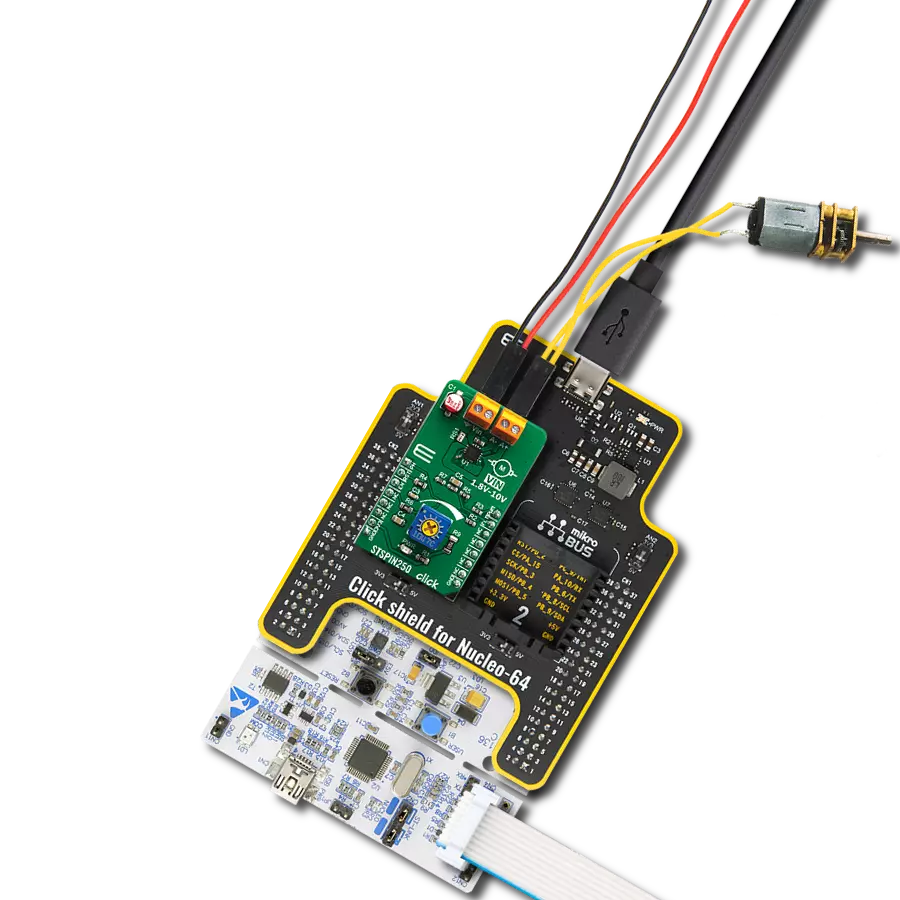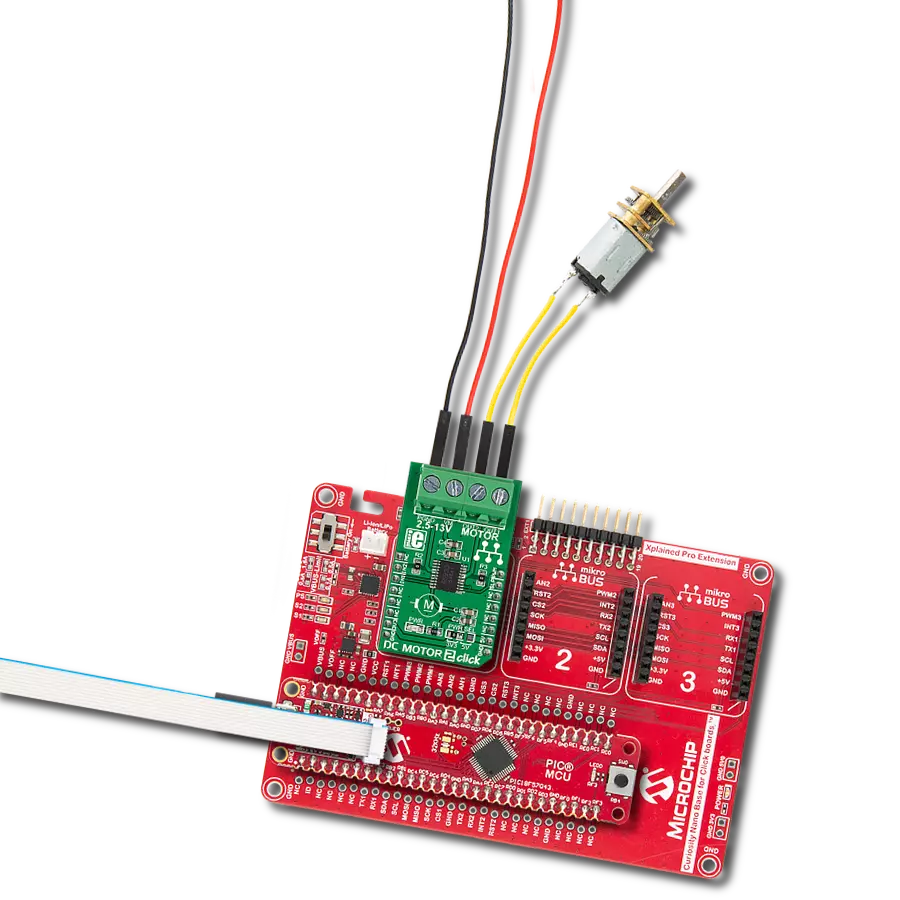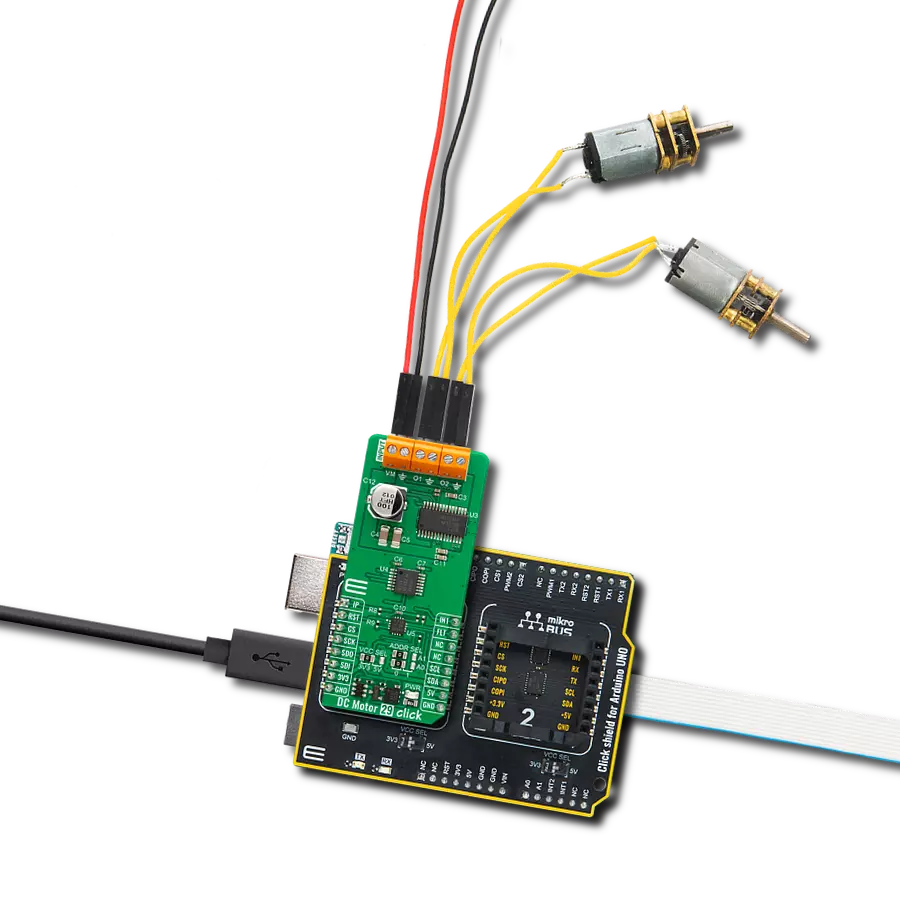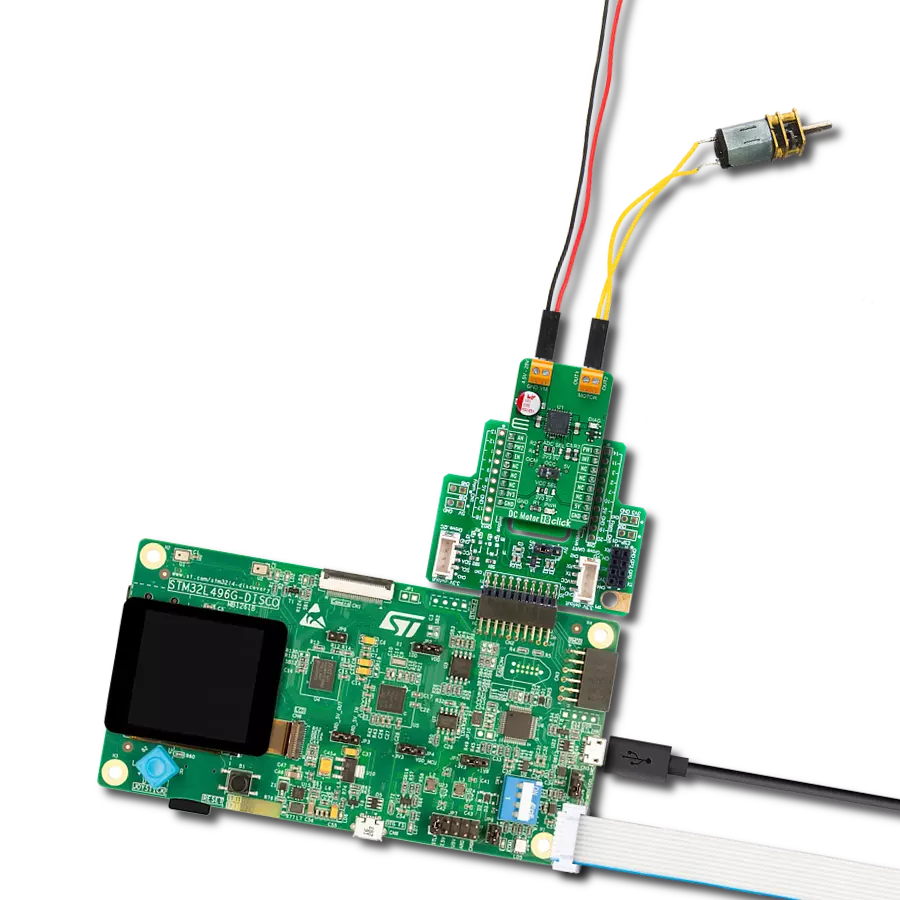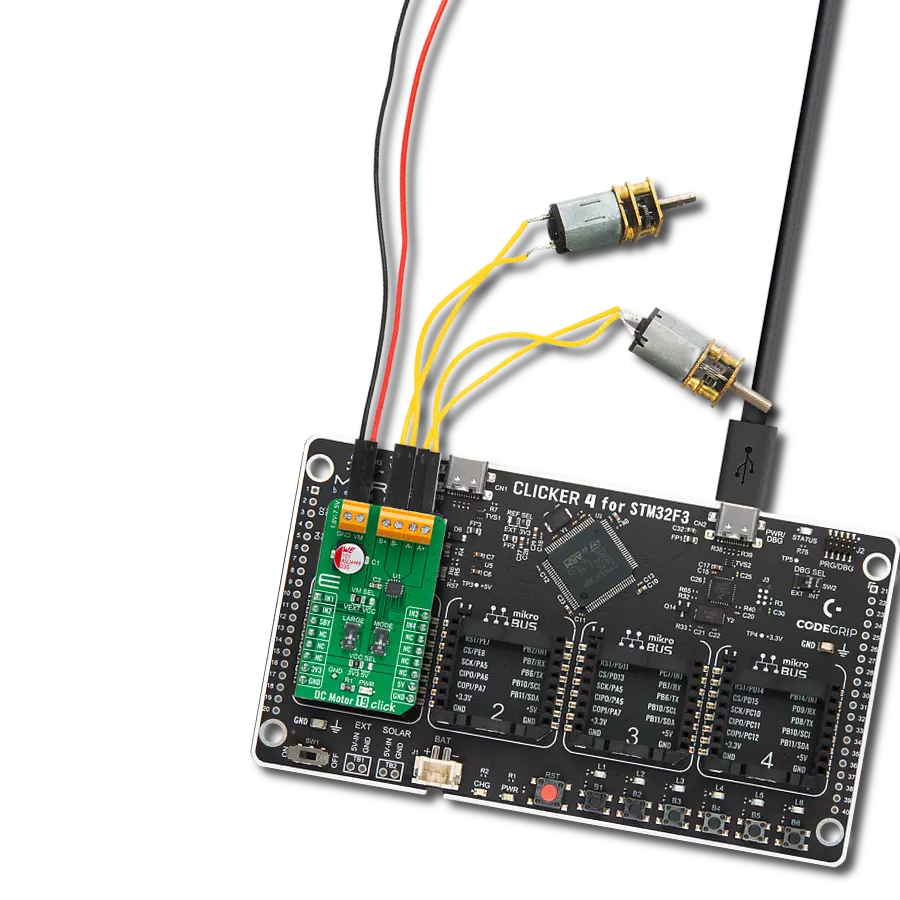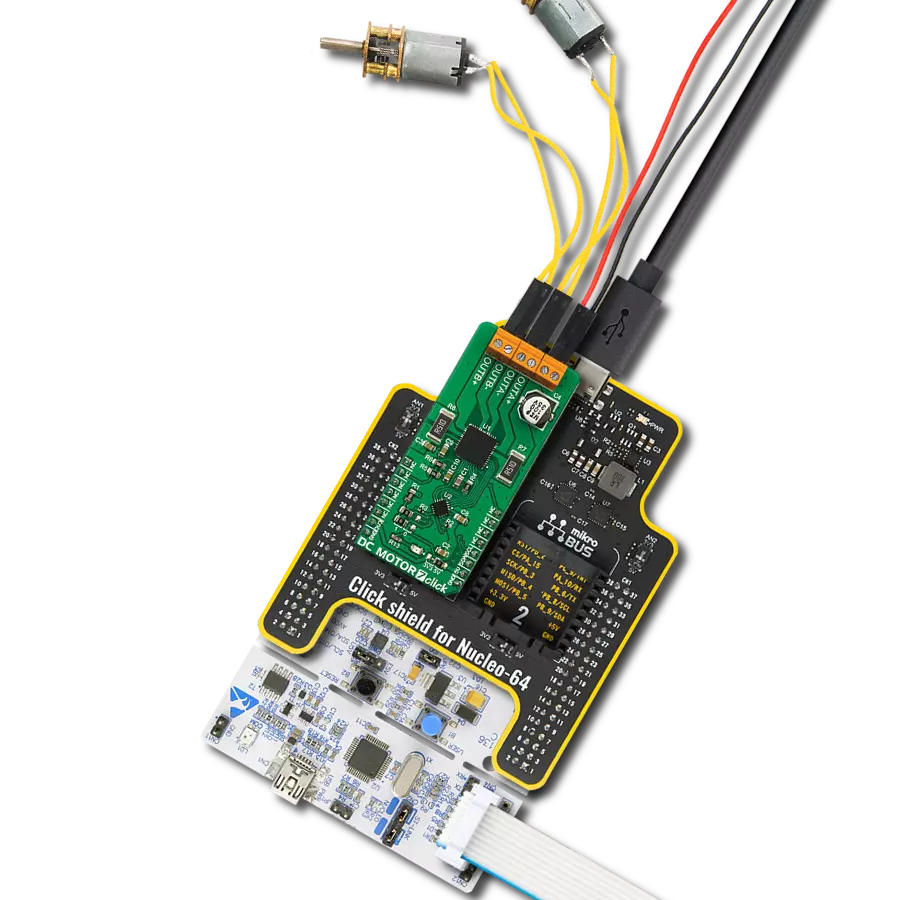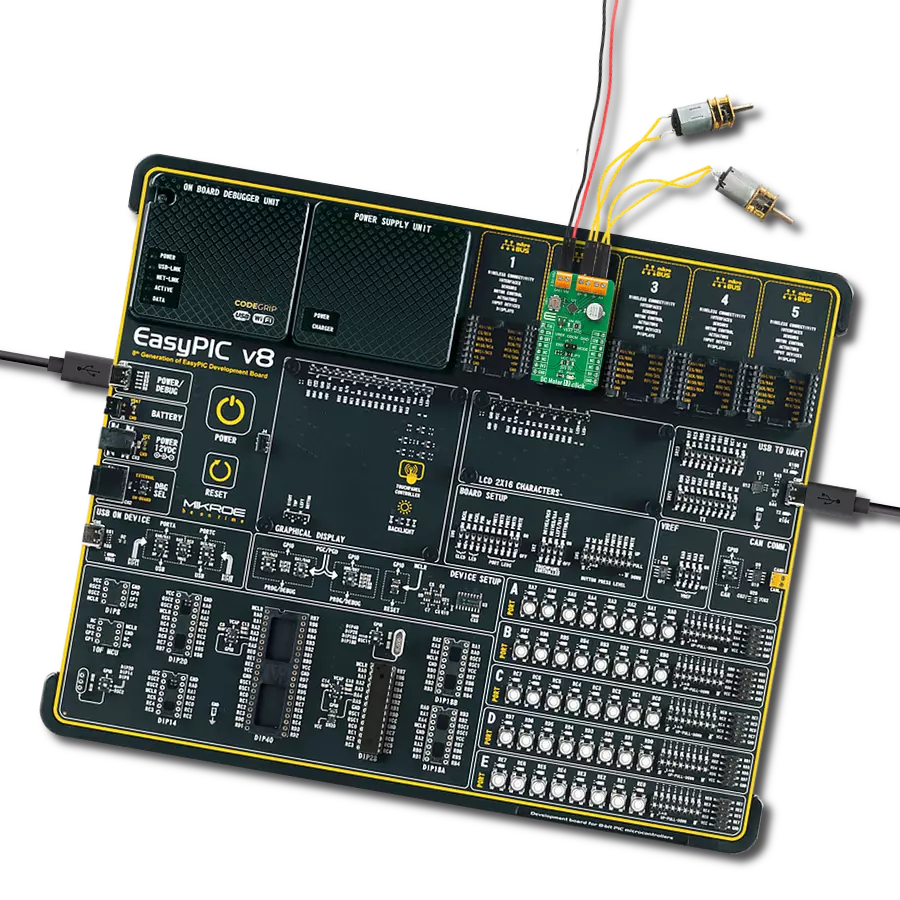Compact and adaptable solution for managing motor-driven functions in various applications
A
A
Hardware Overview
How does it work?
H-Bridge 15 Click is based on the DRV8834, a dual-bridge stepper or DC motor driver from Texas Instruments. The output driver block of each H-Bridge consists of N-channel power MOSFETs configured as an H-Bridge to drive the motor windings. Each H-Bridge includes circuitry to regulate or limit the winding current. There are two general control modes. The indexer logic with simple step/direction control and up to 1/32-step micro-stepping is one. The other is a phase/enable control that can drive external references for more than 1/32-step micro-stepping. The PCA9538, a low-voltage 8-bit I/O port from NXP, controls the logic states of the motor driver inputs. By setting the CONFIG input pin of the motor driver to a HIGH
state, you can select the indexer mode. Otherwise, you can select the phase/enable mode. Please note that you can drive DC motors only in phase/enable mode, while a stepper motor can be driven in any of these. The PCA9538 allows you to control the enable inputs of both bridges, micro-step modes, step inputs, direction, sleep mode, and more. It even takes the fault outputs of the motor driver. The voltage reference for both bridges is provided by the motor driver voltage reference output and two onboard potentiometers labeled VREF A and VREF B. Over those potentiometers, you can set the winding current for both bridges. The decay modes for both bridges are left for you to set over unpopulated jumper resistors. H-Bridge
15 Click uses a standard 2-wire I2C interface of the PCA9538 to allow the host MCU to control the motor driver inputs. It also notifies the host MCU if any fault condition occurs over the INT pin. The RST pin allows you to reset the PCA9538. The i2c address for this I/O port can be set over the I2C ADDR jumpers. There is also the ENA pin, which, in indexer mode, can turn all outputs on or off. This Click board™ can operate with either 3.3V or 5V logic voltage levels selected via the VCC SEL jumper. This way, both 3.3V and 5V capable MCUs can use the communication lines properly. Also, this Click board™ comes equipped with a library containing easy-to-use functions and an example code that can be used for further development.
Features overview
Development board
Fusion for ARM v8 is a development board specially designed for the needs of rapid development of embedded applications. It supports a wide range of microcontrollers, such as different ARM® Cortex®-M based MCUs regardless of their number of pins, and a broad set of unique functions, such as the first-ever embedded debugger/programmer over WiFi. The development board is well organized and designed so that the end-user has all the necessary elements, such as switches, buttons, indicators, connectors, and others, in one place. Thanks to innovative manufacturing technology, Fusion for ARM v8 provides a fluid and immersive working experience, allowing access anywhere and under any
circumstances at any time. Each part of the Fusion for ARM v8 development board contains the components necessary for the most efficient operation of the same board. An advanced integrated CODEGRIP programmer/debugger module offers many valuable programming/debugging options, including support for JTAG, SWD, and SWO Trace (Single Wire Output)), and seamless integration with the Mikroe software environment. Besides, it also includes a clean and regulated power supply module for the development board. It can use a wide range of external power sources, including a battery, an external 12V power supply, and a power source via the USB Type-C (USB-C) connector.
Communication options such as USB-UART, USB HOST/DEVICE, CAN (on the MCU card, if supported), and Ethernet is also included. In addition, it also has the well-established mikroBUS™ standard, a standardized socket for the MCU card (SiBRAIN standard), and two display options for the TFT board line of products and character-based LCD. Fusion for ARM v8 is an integral part of the Mikroe ecosystem for rapid development. Natively supported by Mikroe software tools, it covers many aspects of prototyping and development thanks to a considerable number of different Click boards™ (over a thousand boards), the number of which is growing every day.
Microcontroller Overview
MCU Card / MCU

Type
8th Generation
Architecture
ARM Cortex-M4
MCU Memory (KB)
1024
Silicon Vendor
STMicroelectronics
Pin count
144
RAM (Bytes)
262144
You complete me!
Accessories
DC Gear Motor - 430RPM (3-6V) represents an all-in-one combination of a motor and gearbox, where the addition of gear leads to a reduction of motor speed while increasing the torque output. This gear motor has a spur gearbox, making it a highly reliable solution for applications with lower torque and speed requirements. The most critical parameters for gear motors are speed, torque, and efficiency, which are, in this case, 520RPM with no load and 430RPM at maximum efficiency, alongside a current of 60mA and a torque of 50g.cm. Rated for a 3-6V operational voltage range and clockwise/counterclockwise rotation direction, this motor represents an excellent solution for many functions initially performed by brushed DC motors in robotics, medical equipment, electric door locks, and much more.
The 28BYJ-48 is an adaptable 5VDC stepper motor with a compact design, ideal for various applications. It features four phases, a speed variation ratio of 1/64, and a stride angle of 5.625°/64 steps, allowing precise control. The motor operates at a frequency of 100Hz and has a DC resistance of 50Ω ±7% at 25°C. It boasts an idle in-traction frequency greater than 600Hz and an idle out-traction frequency exceeding 1000Hz, ensuring reliability in different scenarios. With a self-positioning torque and in-traction torque both exceeding 34.3mN.m at 120Hz, the 28BYJ-48 offers robust performance. Its friction torque ranges from 600 to 1200 gf.cm, while the pull-in torque is 300 gf.cm. This motor makes a reliable and efficient choice for your stepper motor needs.
Used MCU Pins
mikroBUS™ mapper
Take a closer look
Click board™ Schematic

Step by step
Project assembly
Track your results in real time
Application Output
1. Application Output - In Debug mode, the 'Application Output' window enables real-time data monitoring, offering direct insight into execution results. Ensure proper data display by configuring the environment correctly using the provided tutorial.

2. UART Terminal - Use the UART Terminal to monitor data transmission via a USB to UART converter, allowing direct communication between the Click board™ and your development system. Configure the baud rate and other serial settings according to your project's requirements to ensure proper functionality. For step-by-step setup instructions, refer to the provided tutorial.

3. Plot Output - The Plot feature offers a powerful way to visualize real-time sensor data, enabling trend analysis, debugging, and comparison of multiple data points. To set it up correctly, follow the provided tutorial, which includes a step-by-step example of using the Plot feature to display Click board™ readings. To use the Plot feature in your code, use the function: plot(*insert_graph_name*, variable_name);. This is a general format, and it is up to the user to replace 'insert_graph_name' with the actual graph name and 'variable_name' with the parameter to be displayed.

Software Support
Library Description
This library contains API for H-Bridge 15 Click driver.
Key functions:
hbridge15_set_pins- H-Bridge 15 set pins function.hbridge15_set_sleep- H-Bridge 15 set sleep function.hbridge15_set_out_state- H-Bridge 15 set output function.
Open Source
Code example
The complete application code and a ready-to-use project are available through the NECTO Studio Package Manager for direct installation in the NECTO Studio. The application code can also be found on the MIKROE GitHub account.
/*!
* @file main.c
* @brief H-Bridge 15 Click example
*
* # Description
* This example demonstrates the use of the H-Bridge 15 Click board by
* driving the motor in both directions with braking and freewheeling.
*
* The demo application is composed of two sections :
*
* ## Application Init
* Initializes the driver and performs the Click default configuration.
*
* ## Application Task
* This example is driving a motor in both directions with
* motor braking and freewheeling in between.
*
* @author Stefan Ilic
*
*/
#include "board.h"
#include "log.h"
#include "hbridge15.h"
static hbridge15_t hbridge15;
static log_t logger;
void application_init ( void )
{
log_cfg_t log_cfg; /**< Logger config object. */
hbridge15_cfg_t hbridge15_cfg; /**< Click config object. */
/**
* Logger initialization.
* Default baud rate: 115200
* Default log level: LOG_LEVEL_DEBUG
* @note If USB_UART_RX and USB_UART_TX
* are defined as HAL_PIN_NC, you will
* need to define them manually for log to work.
* See @b LOG_MAP_USB_UART macro definition for detailed explanation.
*/
LOG_MAP_USB_UART( log_cfg );
log_init( &logger, &log_cfg );
log_info( &logger, " Application Init " );
// Click initialization.
hbridge15_cfg_setup( &hbridge15_cfg );
HBRIDGE15_MAP_MIKROBUS( hbridge15_cfg, MIKROBUS_1 );
if ( I2C_MASTER_ERROR == hbridge15_init( &hbridge15, &hbridge15_cfg ) )
{
log_error( &logger, " Communication init." );
for ( ; ; );
}
if ( HBRIDGE15_ERROR == hbridge15_default_cfg ( &hbridge15 ) )
{
log_error( &logger, " Default configuration." );
for ( ; ; );
}
log_info( &logger, " Application Task " );
}
void application_task ( void )
{
log_printf( &logger, " Motor in forward mode. \r\n" );
hbridge15_set_out_state( &hbridge15, HBRIDGE15_DRIVE_MOTOR_FORWARD );
Delay_ms ( 1000 );
Delay_ms ( 1000 );
Delay_ms ( 1000 );
Delay_ms ( 1000 );
Delay_ms ( 1000 );
log_printf( &logger, " Motor brake is on \r\n" );
hbridge15_set_out_state( &hbridge15, HBRIDGE15_DRIVE_MOTOR_BRAKE );
Delay_ms ( 1000 );
Delay_ms ( 1000 );
log_printf( &logger, " Motor in reverse mode. \r\n" );
hbridge15_set_out_state( &hbridge15, HBRIDGE15_DRIVE_MOTOR_REVERSE );
Delay_ms ( 1000 );
Delay_ms ( 1000 );
Delay_ms ( 1000 );
Delay_ms ( 1000 );
Delay_ms ( 1000 );
log_printf( &logger, " Motor is coasting \r\n" );
hbridge15_set_out_state( &hbridge15, HBRIDGE15_DRIVE_MOTOR_FREEWHEEL );
Delay_ms ( 1000 );
Delay_ms ( 1000 );
}
int main ( void )
{
/* Do not remove this line or clock might not be set correctly. */
#ifdef PREINIT_SUPPORTED
preinit();
#endif
application_init( );
for ( ; ; )
{
application_task( );
}
return 0;
}
// ------------------------------------------------------------------------ END






















